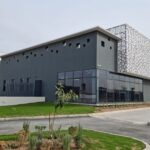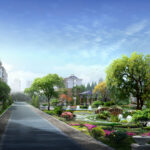From an abandoned structure to a first-class medical facility: how adaptive reuse can support the healthcare sector.
Demand for healthcare is at an all-time high. Medical technology and research are quickly developing and the accessibility of information via online media sources has resulted in an increase in public knowledge. People are keener than ever to improve their health and wellbeing and access medical services. Medical tourism is making a quick comeback now that border restrictions are relaxing and we are seeing many governments plan for additional investments in healthcare services.
In addition, the quickly increasing rate of global population growth, the ever increasing density of major cities, and the world’s aging population are all contributing to a greater requirement for medical facilities.
Healthcare services are under pressure in many areas, but this high demand and requirement along with the progress and developments ahead, make it a very exciting time for the ever evolving medical and healthcare industry.
Governments and healthcare providers are trying to manage the health of their citizens and economies in the best way they can, but unfortunately we are seeing a lot of cities, towns and neighborhoods with a lack of healthcare facilities, or simply a lack of capacity to provide the much needed services required by the communities they serve.
There is high demand for quicker and easier access to healthcare, but unfortunately this cannot be provided equally in many locations. In some congested areas, the existing hospitals are not easily accessible, meanwhile there are some neighborhoods where we will see a surplus of medical facilities.
In recent years, and this year especially, the world’s economies are taking a hit, business is reduced for most industries, and buildings that were once designed with exciting prospects and uses in mind have found themselves empty, disused and unfulfilled.
But perhaps, instead of remaining unoccupied and underachieving, these buildings could serve the community better when repurposed into hospitals, healthcare centers, clinics, rehabilitation centers, laboratories or research centers, especially now, at the time when communities need them the most.
This is part 3 of our ongoing Repurpose or renovate? series, that explores the ways that the adaptive reuse and renovation of different types of buildings can help support a variety of industries through the impacts that the pandemic has had on business, healthcare and governments worldwide.
If the events of this year have made anything clear, it is which cities or countries are in most need of medical facilities.
Unfortunately, many hospitals, particularly in densely populated cities, simply did not have the capacity to provide adequate medical attention to the communities they serve, even before the pandemic hit. Now, COVID-19 cases have taken over hospitals and hospital operations, and the waiting lists have massively increased for patients requiring other types of medical care. Unfortunately, these are issues we are likely to see last for a very long time.
Although COVID-19 cases will gradually decrease over time, we cannot rely on the increased capacity requirements of hospitals only being temporary. Other factors putting strain on medical facilities include the aging global population and the ever increasing rate of worldwide population growth.
While the world was not prepared for the extraordinary impacts of COVID-19 and the speed at which they grew, we can be prepared to tackle future health crises and incidents by ensuring the necessary facilities are in place to support communities.
Governments must aim to help to build back their cities and communities stronger, more resilient and more able to tackle any future difficulties, in order to protect their citizens and create an environment in which their economies can recover.
Many reports imply that we can expect to see an increase in healthcare-related expenditure in the coming years, a positive sign for healthcare providers and the private healthcare industry.
Healthcare related expenditure in the Gulf has grown from $60bn to $76bn between 2013 and 2019, and is expected to grow up to $89bn by 2022, an overall increase of almost 50%. Private sector healthcare spending is also forecasted to increase between 2018 and 2022 at a cumulative annual growth rate of 9.5%, compared to a government contribution growth rate of 4.4%. In addition, while tourism has taken a massive hit this year, medical tourism seems to be on the rise in the Middle East and particularly in Dubai, showing signs of a quick post-COVID comeback. New models of healthcare are also predicted to emerge, with greater digitalization and increased spending on innovation in the industry.
These figures and predictions could be great news for newly established medical facilities, or medical facilities that are able to undergo renovations and updates in the near future. Newer or newly renovated facilities are likely to be able to stay at the forefront of the industry with the introduction of these developments and investments.
Now that we know which areas could benefit from having more healthcare facilities, we can learn from the recent events and be prepared to anticipate the needs of communities to ensure services are available where and when they are required.
It is certainly worth considering adapting obsolete buildings that have lost their purpose over time, or that have become disused as a result of the pandemic, for a new function that will serve the community and prove economically viable.
In fact, it would be more effective to repurpose an existing city building to provide healthcare services, than to build an entirely new facility from scratch.
To build a new medical facility will take far longer before it can be ready to serve the community. In most cases, it would also have to be built somewhere far outside of the city due to the space available in the areas that would most need it. Not to mention, existing buildings are already accessible by road and transport networks and the outcome would be much better for the environment.
A successful case to consider is Abdali Medical Center in Amman, Jordan.
The project was initially being developed as a mixed-use residential and commercial building, however the 2009 global financial crisis caused construction to be abandoned due to financial problems. In 2014, Greater Amman Municipality planned to build a hospital in Abdali to stimulate investment in Jordan’s medical sector, and resumed construction within the abandoned building.
CCG worked on this project alongside AECOM, who as a result won MEP Middle East’s award for 2020 Retrofit Project of the Year. Together we repurposed the unfinished residential and commercial tower into a multidisciplinary medical center that now provides world-class patient-centered healthcare services for the community, promotes research and education in the region and is powered by the largest solar plant to power a single healthcare facility.
In addition to permanent medical facilities, this year we have seen many examples around the world of temporary field hospitals that have been developed to ease the strain on national healthcare services.
It has been interesting and inspiring to witness the creativity that has arisen from this crisis and to learn about the range of alternative facilities, buildings and venues that have been adapted and repurposed with speed into temporary healthcare facilities.
In London, the Excel exhibition center that usually hosts shows, expos and conferences was converted into ‘NHS Nightingale’, a temporary hospital with 4,000 intensive care beds.
It was built in just 9 days with the help of up to 200 soldiers a day. The scale and timeframe for the construction of this facility were unlike any other healthcare project. The framework for individual bed bays and bedheads were created using lightweight and quick to produce materials that are usually used to make exhibition stands.
Elsewhere in the UK, to provide further help in easing pressure on the NHS, additional ‘NHS Nightingales’ have been set up in regional conference centers and sports facilities such as football stadiums. Once the number of COVID-19 cases began to reduce, many of these temporary facilities were repurposed as specialist cancer care units, to help handle the undiagnosed and untreated cancer cases that had risen in number as a result of the disrupted health services during the pandemic.
To support Jordan in its battle against COVID-19, CCG provided the government with design and build field hospital designs for hospitals in 3 locations.
These facilities are designed to lock down, isolate and treat COVID-19 cases to reduce the impact on the national health sector. Each hospital will include 250 beds for moderate cases and 50 intensive care unit beds with an estimated total area of 18,000m2.
The facility features flow control zones and transport loops to reduce transmission risk between staff and groups of patients, thermal cameras are placed throughout the hospital and video conferencing facilities are implemented for monitoring operations and conducting briefings with government officials and decision makers.
In the UAE, authorities created temporary field hospitals within the Abu Dhabi Exhibition Centre, Abu Dhabi’s Emirates Humanitarian City, the Dubai World Trade Center and Dubai Parks and Resorts.
This helped to increase the country’s capacity to treat those infected with COVID-19. The three hospitals in Abu Dhabi, had a total capacity of 3,600 and Dubai’s World Trade Center provided 3,000 beds. Although only developed as a temporary facility, Abu Dhabi’s National Exhibition Centre field hospital ensures a world-class patient experience with quarantine patient rooms equipped with state-of-the-art equipment, recreational facilities for health and fitness needs, high-speed internet and personal iPads for all patients as well as an engaging activities scheduled throughout their stay.
The USA also saw a variety of spaces being converted into temporary field hospitals.
We have seen university dormitories and campus facilities that were out of use due to classes being dismissed, versatile hotels and motels that were experiencing low occupancy rates and fairgrounds that are only really used at high capacity for a few weeks of the year but that have vast space with necessary infrastructure, all be transformed and utilized as temporary hospitals.
We admire the creativity and inspirational thinking of these teams around the world, and it has been uplifting to see how people have come together to support each other in this unusual time. While the field hospitals have been established as temporary facilities with speed of development being a main priority, governments and healthcare developers are now armed with more knowledge and understanding of what kinds of permanent facilities can bring the most benefit to their communities, and they have time to be able to develop them effectively.
We love to see successful examples of adaptive reuse in buildings and architecture, particularly when it can help to elevate the wellbeing and living standards of the surrounding communities.
This is part 3 of our ongoing Repurpose or renovate? series, that explores the ways that the adaptive reuse and renovation of different types of buildings can help support a variety of industries through the impacts that the pandemic has had on business, healthcare and governments worldwide.
Click here to read the previous article in the series.
Click here to view the following article in the series.
Ghaith Abujaber is CCG’s Executive Director of Global Business Development and is based in Dubai. His rich experience includes previous positions at major real estate and tourism companies, as well as work on private and governmental projects. This has given him an excellent insight into how these types of organizations are developing across the region.












